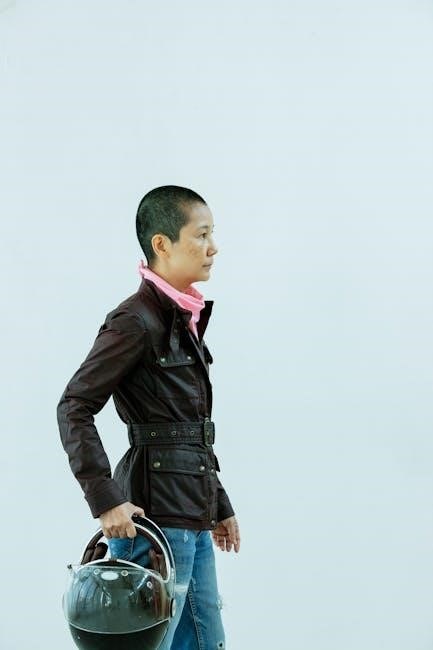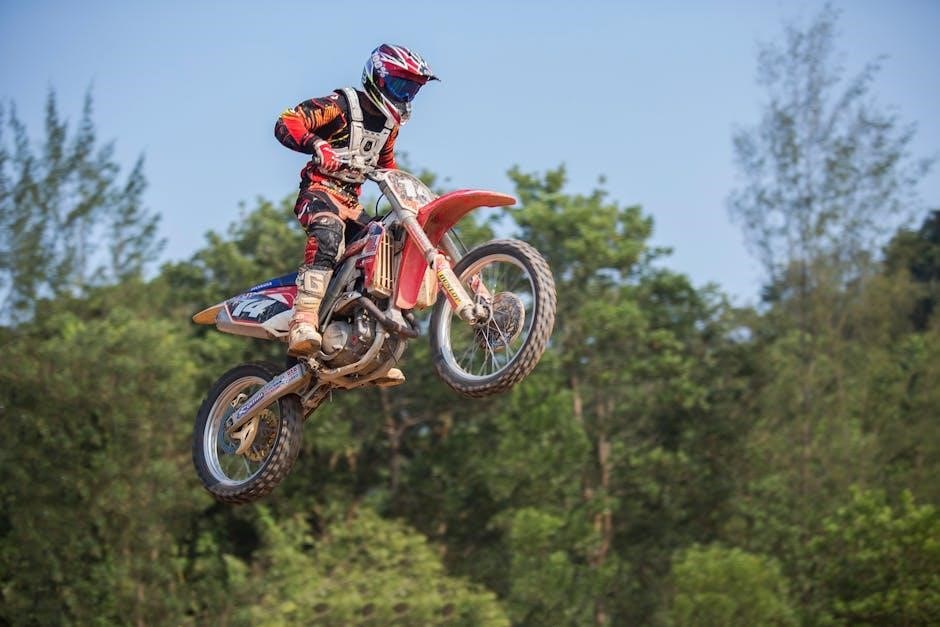
motorcycle jacket size guide
A motorcycle jacket’s fit is crucial for both safety and style‚ acting as a second skin while allowing unhindered movement. Proper sizing ensures optimal comfort and protection‚ essential for every ride.
1.1 Importance of Proper Fit for Safety and Comfort
A proper fit in a motorcycle jacket is essential for both safety and comfort. A jacket that fits correctly provides optimal protection while allowing freedom of movement. It should feel like a second skin‚ hugging your body without restricting mobility. Incorrect sizing can lead to discomfort during long rides or even safety hazards‚ as an ill-fitting jacket may not function as intended. Ensuring the right balance between safety features and ergonomic design is vital for every rider.
1.2 Overview of Motorcycle Jacket Styles
Motorcycle jackets come in various styles to suit different riding preferences and needs. Cruiser jackets are classic and relaxed‚ often made from leather‚ while sport jackets are sleek and form-fitting‚ designed for high-speed performance. Adventure jackets offer versatility with adjustable features‚ catering to both on-road and off-road conditions. Each style provides unique benefits‚ ensuring riders can choose a jacket that aligns with their riding lifestyle and preferences for comfort‚ protection‚ and functionality.

Understanding Motorcycle Jacket Fit Types
Motorcycle jackets vary in fit to cater to different riding styles and body types. Slim‚ regular‚ race‚ and casual fits ensure comfort and mobility for every rider.
2.1 Slim Fit vs. Regular Fit
A slim fit jacket is tailored closer to the body‚ offering a more streamlined appearance while maintaining mobility. It suits riders with a leaner build or those preferring a modern‚ sporty look. In contrast‚ a regular fit provides a more relaxed silhouette‚ accommodating broader shoulders and torso. It’s ideal for riders seeking comfort over long distances or those who prefer a classic style. Both fits ensure functionality but cater to different aesthetic and comfort preferences‚ making the choice dependent on personal style and riding needs.
2.2 Race Fit vs. Casual Fit
A race fit jacket is designed for performance‚ offering a snug‚ streamlined silhouette that enhances mobility during aggressive riding; It’s ideal for serious motorcyclists prioritizing speed and precision. In contrast‚ a casual fit jacket provides a relaxed‚ comfortable design suitable for everyday wear or touring. It allows for easier movement and layering‚ making it perfect for riders seeking versatility and comfort without compromising protection. Both styles cater to distinct riding preferences‚ ensuring optimal fit for specific needs.
2.3 European vs. American Sizing Standards
European and American sizing standards differ significantly. European sizes tend to be smaller and more tailored‚ while American sizes are generally more generous. For example‚ a European size 48 often corresponds to an American size 38. This discrepancy can affect fit‚ especially in the chest and waist measurements. Riders should compare size charts carefully and consider their body type to ensure the best fit. Always check brand-specific charts‚ as sizing varies across regions and brands.

How to Measure Yourself for a Motorcycle Jacket
Accurate measurements are crucial for the perfect fit. Measure chest‚ waist‚ and sleeve length while standing straight. Use a flexible tape measure snugly but not tightly for precise sizing.
3.1 Chest Measurement: Step-by-Step Guide
- Stand upright with shoulders relaxed and arms at your sides.
- Wrap a flexible tape measure around the widest part of your chest‚ typically just under the armpits.
- Ensure the tape is level and parallel to the floor‚ not too tight or too loose.
- Take note of the measurement in inches or centimeters.
- This measurement corresponds to the jacket’s chest size; consider wearing a shirt similar to what you’ll ride in for accuracy.
- For the best fit‚ take multiple measurements and average them if needed.
Accurate chest measurement ensures optimal safety and comfort while riding.
3.2 Waist Measurement: Key Considerations
- Measure your natural waistline‚ typically 1-2 inches above your belly button.
- Stand straight and keep the tape measure level and snug but not overly tight.
- This measurement helps determine the jacket’s fit around your midsection.
- Consider the jacket style‚ as some designs have a more tailored waist.
- Accurate waist measurement ensures comfort and prevents restrictive movement.
Waist measurement is crucial for a balanced fit‚ especially for jackets with adjustable features.
3.3 Sleeve Length Measurement: Tips for Accuracy
To ensure accurate sleeve length‚ measure from the center back of your neck‚ over your shoulder‚ and down to your wrist with your arm slightly bent. Use a flexible tape measure and keep your arm relaxed. This ensures the jacket fits comfortably while riding. Proper sleeve length prevents bunching and ensures armor stays in place. Measure to where the cuff will sit on your wrist for the best fit. Accuracy here is key for both comfort and functionality.
Fabric and Material Considerations
Fabric and material choices significantly impact motorcycle jacket fit and functionality. Leather offers durability‚ while textiles provide flexibility. Weather resistance and breathability are crucial for comfort and safety.
4.1 Leather Jackets: Fit and Sizing Differences
Leather jackets offer exceptional durability and protection but have unique fit characteristics. Unlike textiles‚ leather is less forgiving and may require breaking in for optimal comfort. Sizing can vary due to leather’s natural stiffness‚ which relaxes over time. Riders should consider the jacket’s intended use‚ as sport leathers are snug for aerodynamics‚ while cruiser styles offer a looser fit. Always try on leather jackets to account for any size variations between brands and ensure proper mobility.
4.2 Textile Jackets: Stretch and Flexibility Factors
Textile jackets prioritize flexibility and comfort‚ often featuring stretch panels for enhanced mobility. Fabrics like polyester and nylon blend durability with elasticity‚ allowing natural movement while riding. The fit may vary depending on the material’s weight and weave‚ with lighter textiles offering more flexibility. Unlike leather‚ textiles maintain their stretch without requiring a break-in period‚ making them ideal for riders seeking comfort without compromising protection. Consider the fabric’s elasticity when choosing sizes for optimal fit and performance.
4.3 How Fabric Weight Affects Fit
Fabric weight significantly impacts motorcycle jacket fit. Heavier materials‚ like thick leather or robust textiles‚ offer durability but may feel restrictive if sized too tightly. Lighter fabrics‚ such as lightweight nylon‚ provide flexibility and drape naturally. Riders should consider fabric weight when choosing sizes‚ as heavier materials may require a slightly looser fit for comfort‚ while lighter fabrics can fit more snugly without feeling bulky. Proper sizing ensures optimal mobility and protection regardless of fabric weight.

Motorcycle Jacket Size Charts
Motorcycle jacket size charts provide standardized measurements for chest‚ waist‚ and sleeve lengths‚ helping riders choose the right fit based on body dimensions and style preferences.
5.1 Standard Size Charts: Chest and Waist Measurements
Standard size charts for motorcycle jackets typically include chest and waist measurements‚ providing a baseline for fit. These charts are designed to align with common body types‚ ensuring comfort and functionality. Chest measurements are usually the primary focus‚ as jackets are tailored to fit snugly around the torso for safety. Waist measurements are also crucial‚ especially for styles that cinch or adjust. Always refer to the manufacturer’s chart for accurate sizing‚ as standards can vary slightly between brands and styles.
5.2 Brand-Specific Size Charts: Key Differences
Brand-specific size charts vary significantly due to differences in design‚ materials‚ and target audiences. Some brands cater to specific body types or riding styles‚ offering tailored fits. European and American brands often have distinct sizing standards. Measurements may focus more on chest‚ waist‚ or sleeve length depending on the brand’s design philosophy. Always consult the brand’s official chart‚ as their sizing may not align with standard or universal measurements. This ensures the best fit for comfort and performance.
5.3 How to Compare Size Charts Across Brands
To compare size charts across brands‚ start by measuring yourself consistently using a tape measure. Focus on chest‚ waist‚ and sleeve lengths. Align these measurements with each brand’s chart‚ noting differences in fit descriptions. Some brands offer size converters or fit guides. Check customer reviews for insights on sizing accuracy. Use virtual sizing tools if available. Always consider riding style and jacket type‚ as fit preferences may vary. This ensures a more accurate comparison and better fit selection.
Factors Influencing Jacket Size
Body type and layering significantly influence jacket size. Riders with broader shoulders or longer torsos may need larger sizes. Layering base layers or armor requires adjusting sizes for optimal comfort and mobility.
6.1 Body Type: How Shoulders‚ Torso‚ and Waist Shape Fit
A rider’s body type significantly impacts jacket fit. Broad shoulders require a larger size to avoid restriction‚ while a longer torso needs extended back length for coverage. Waist shape influences how snug or loose the jacket sits. Proportions like shoulder-to-waist ratio and torso length must align with the jacket’s design. Muscular builds may need structured styles‚ while petite frames benefit from tailored cuts. Balancing aesthetics and functionality ensures optimal comfort and protection.
6.2 Layering: Accounting for Base Layers and Armor
Layering is crucial when sizing a motorcycle jacket. Base layers like thermal tops or fleece add bulk‚ requiring a slightly larger size. Integrated or removable armor also impacts fit‚ as it can make the jacket feel tighter. Consider the thickness of materials and how they affect mobility. A jacket should fit comfortably with all layers‚ ensuring freedom of movement. Neglecting to account for layering can lead to restricted motion and discomfort‚ compromising both safety and riding experience.

Common Mistakes to Avoid When Sizing
Common mistakes include ignoring chest-to-waist proportions‚ not considering riding position‚ and overlooking fabric flexibility. These oversights can lead to poor fit and discomfort.
7.1 Ignoring Chest vs. Waist Proportions
Ignoring chest vs. waist proportions is a common mistake that can lead to an ill-fitting jacket. A jacket that fits the chest but is too tight at the waist‚ or vice versa‚ compromises both comfort and protection. Riders should ensure their measurements align with the jacket’s design‚ as poor fit can restrict movement or leave gaps‚ affecting safety and functionality. Always consider both measurements for optimal fit and performance.
7.2 Not Considering Riding Position
Not considering riding position can lead to discomfort and poor protection. Sport riders need a snug fit for high-speed maneuvers‚ while cruiser riders prefer a relaxed fit for upright comfort. Failing to match jacket fit to riding style can result in restricted movement or inadequate coverage. Always choose a jacket designed for your riding position to ensure optimal comfort‚ mobility‚ and safety. This ensures the jacket performs as intended during your specific type of riding.
7.3 Overlooking Fabric Stretch and Flexibility
Overlooking fabric stretch and flexibility can compromise comfort and safety. Jackets with stretch panels‚ like those made from elastane or mesh‚ offer better mobility. Ignoring this aspect may result in a restrictive fit‚ especially when riding. Always check the fabric’s flexibility and how it moves with your body. A jacket that doesn’t stretch can limit arm movement‚ affecting control while riding. Prioritize fabrics that balance protection with flexibility for optimal performance and comfort on the road.

Style vs. Fit: Balancing Aesthetics and Functionality
Style and fit must harmonize to ensure both aesthetics and functionality. Choose a jacket that matches your riding needs while maintaining a look you prefer.
8.1 Cruiser Jackets: Relaxed Fit for Comfort
Cruiser jackets offer a relaxed fit‚ prioritizing comfort for long rides. Designed with a looser cut‚ they provide freedom of movement and accommodate layering. Ideal for upright riding positions‚ these jackets often feature classic styling with minimal hardware. While they may lack the snugness of sport jackets‚ they excel in comfort‚ making them perfect for casual‚ laid-back rides. Ensure proper sizing to maintain protection without sacrificing the relaxed fit intended for cruiser styles.
8.2 Sport Jackets: Snug Fit for Performance
Sport jackets are designed for a snug‚ aerodynamic fit‚ optimizing performance during high-speed rides. The tailored cut reduces wind resistance and enhances mobility. Pre-curved sleeves align with the riding position‚ improving comfort and control. While they may feel tighter than cruiser jackets‚ this ensures better protection and responsiveness. Proper sizing is critical to balance snugness with freedom of movement‚ ensuring safety and performance without compromise.
8.3 Adventure Jackets: Versatile Fit for Multiple Conditions
Adventure jackets offer a versatile fit designed for varying terrains and weather. They typically feature adjustable cuffs‚ hem‚ and waist for customization. Reinforced materials ensure durability‚ while breathable panels enhance comfort. The slightly relaxed fit accommodates layering and armor without restricting movement. These jackets are ideal for long-distance rides‚ blending protection with adaptability. Proper sizing ensures optimal performance across diverse riding conditions‚ making them a practical choice for adventurous motorcyclists seeking both functionality and comfort.

How to Choose the Right Brand for Your Size
Selecting a brand that aligns with your measurements ensures a perfect fit. Research sizing charts‚ read reviews‚ and compare fits to find brands tailored to your body type.
9.1 Understanding Brand-Specific Sizing
Each brand tailors its sizing to specific body types or styles‚ so fits can vary significantly. European brands often run slimmer‚ while American brands may offer a roomier cut. Always consult the brand’s size chart‚ as some cater to broader shoulders or longer torsos. Reading reviews can provide insights into how others size their jackets within the same brand. Virtual sizing tools can also help match your measurements to the brand’s unique fit profile for accuracy.
9.2 Reading Reviews for Fit Feedback
Reading reviews from other customers is crucial for gauging how a jacket fits; Riders often share insights into whether sizes run true‚ small‚ or large. Pay attention to comments about chest‚ shoulder‚ and sleeve measurements. Reviews can highlight if a jacket is suited for specific body types or riding styles. This feedback helps you make informed decisions‚ especially when buying online without the chance to try it on. Use this collective experience to refine your size choice for the best fit.
9.3 Using Virtual Size Guides and Tools
Virtual size guides and tools are invaluable for ensuring accurate fit without physical try-ons. Many brands offer interactive size calculators and 3D avatars to input measurements. These tools compare your data with their size charts to recommend the best fit. Some platforms even allow side-by-side comparisons across brands. Accurate measurements are key for these tools to work effectively. They reduce sizing uncertainty‚ especially for online shoppers‚ by providing personalized recommendations tailored to your body type and the jacket’s design.

Tips for Ensuring the Perfect Fit
Check size charts‚ consider body type‚ and try jackets on when possible. Ensure mobility and comfort while seated in riding position for optimal fit and safety.

10.1 Trying Jackets On vs. Buying Online
Trying jackets on ensures a precise fit‚ allowing you to assess comfort‚ mobility‚ and quality. However‚ it requires visiting a store. Buying online offers convenience but lacks the ability to try before purchase. To mitigate this‚ use detailed size charts‚ read reviews‚ and check return policies. For the best experience‚ combine online research with in-store trials if possible. Prioritize fit accuracy to ensure safety and comfort while riding.
10.2 Importance of Mobility and Flexibility
Mobility and flexibility are crucial for rider comfort and safety. A jacket that restricts movement can hinder control while riding. Look for stretch panels‚ ergonomic designs‚ and articulated elbows to enhance flexibility. Textile jackets often offer more stretch than leather‚ while leather provides durability. Ensure the jacket allows natural shoulder and arm movement‚ especially for sport or adventure riding; Prioritize features that balance protection with ease of motion to maintain control and comfort during dynamic riding conditions.
10.3 Final Check: Zippers‚ Cuffs‚ and Hem Adjustments
A final check ensures all zippers‚ cuffs‚ and hem adjustments function properly. Secure zippers prevent wind intrusion‚ while adjustable cuffs and hem provide a tailored fit. Test all closures to confirm they stay in place during riding. Adjustable features enhance customization‚ ensuring comfort and protection. Properly fitted cuffs and hem prevent flapping in the wind‚ reducing distractions. These details are essential for both safety and a comfortable riding experience‚ ensuring the jacket performs optimally in varying conditions.

The Role of Armor and PADDING in Sizing
Armor and padding add bulk‚ affecting fit. Ensure the jacket size accommodates these without restricting movement. Proper sizing balances protection and mobility for optimal performance.
11.1 How Armor Affects Jacket Fit
Armor significantly impacts jacket fit by adding bulk‚ particularly in the chest‚ shoulders‚ and elbows. Proper sizing ensures the armor stays positioned correctly without restricting movement. A jacket with built-in armor may require a slightly larger size to maintain comfort and flexibility. It’s crucial to consider armor placement and thickness when choosing a size‚ as poor fit can compromise both protection and mobility. Always check if the armor is adjustable or removable to achieve the best fit.
11.2 Choosing Jackets with Adjustable Armor
Opting for jackets with adjustable armor ensures a tailored fit‚ enhancing both comfort and protection. Adjustable armor allows customization to body shape‚ ensuring optimal coverage without sacrificing mobility. This feature is especially beneficial for riders with unique body types or preferences. Look for jackets with removable or repositionable armor to achieve the perfect balance of fit and protection. Adjustable armor also accommodates varying riding styles‚ ensuring safety and flexibility in different conditions.
Proper fit is crucial for safety and comfort. Ensure accurate measurements‚ consider style‚ fabric‚ and armor. Prioritize quality and functionality for optimal riding experience.
Always try jackets on‚ read reviews‚ and use size guides to guarantee the best fit for your needs and preferences.
12.1 Summary of Key Sizing Considerations
Accurate measurements are essential for a proper fit. Consider chest‚ waist‚ and sleeve length‚ and how they align with size charts. Understand your body type and how it influences fit.
Be mindful of fabric type‚ as leather and textiles fit differently. Layering and armor also impact sizing. Prioritize comfort‚ mobility‚ and safety when making your final decision.
12.2 Encouragement to Prioritize Fit for Safety
A proper fit is crucial for safety‚ ensuring armor stays in place and providing optimal protection during impact. Avoid loose jackets that may shift‚ exposing vulnerable areas‚ and tight ones that restrict movement. Comfort and mobility are essential for control and focus while riding. A well-fitting jacket enhances design features like aerodynamics and weather protection‚ reducing accident risks. Invest time in finding the right fit to enhance safety and enjoy a secure‚ comfortable ride.